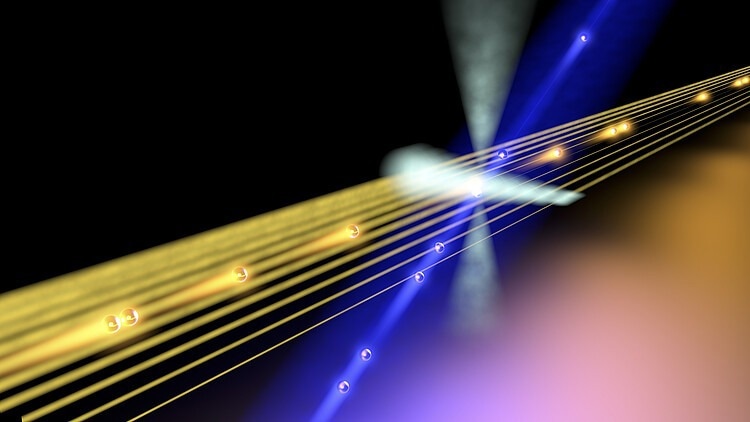A group of researchers from Leibniz University Hannover (Germany) and the University of Strathclyde in Glasgow (United Kingdom) have challenged a preconceived notion regarding the role of multiphoton components in the interference effects of parametric single photons (generated in non-linear crystals) and thermal fields, such as sunlight.
 Artistic representation of quantum interference between a thermal state and a heralded parametric single-photon state. Image Credit: Leibniz University Hannover
Artistic representation of quantum interference between a thermal state and a heralded parametric single-photon state. Image Credit: Leibniz University Hannover
We experimentally proved that the interference effect between thermal light and parametric single photons also leads to quantum interference with the background field. For this reason, the background cannot simply be neglected and subtracted from calculations, as has been the case up to now.
Dr. Michael Kues, Professor and Head, Institute of Photonics Cluster of Excellence, Leibniz University Hannover
Anahita Khodadad Kashi, a Ph.D. Candidate at the Institute of Photonics, was the principal investigator. She studies photonic quantum information processing. She looked into the effects of multiphoton contamination on the visibility of the so-called Hong-Ou-Mandel phenomenon, a quantum interference effect.
With our experiment, we have disproved the previously valid assumption that multiphoton components would only impair visibility and can, therefore, be subtracted in the calculation, and we have discovered a new fundamental characteristic that was not considered in previous calculations. Our newly developed model can predict the quantum interference, and we can measure this effect in an experiment.
Anahita Khodadad Kashi, PhD Candidate, Institute of Photonics, Leibniz University Hannover
How New Knowledge is Created
While doing an experiment in the laser laboratory, the scientists made their discovery. When they first used the original computation approach, they got a negative result.
Khodadad Kashi said, "But the result would have been physically impossible." The group started debugging the computation model and the experimental setup together.
Kues explained, "When an experiment turns out very different from what is expected, scientists start questioning previous assumptions and look for new explanations."
Together, they created a novel theory including parametric single photons and quantum interference of thermal fields. The method was initially tested by Glasgow University of Strathclyde quantum physicist Lucia Caspani.
Subsequently, Khodadad Kashi gave talks on her theory and the experimental findings at major conferences, such as Photonics West in San Francisco, which is the largest photonics and optics specialist conference, with around 22,000 attendees.
She got validation of her findings there and spoke with other scientists about her hypothesis. The team's findings have now been published in the journal Physical Review Letters.
With the novel theory and the experimental confirmation, Kues' group has significantly advanced the knowledge of quantum phenomena.
The findings could be important for quantum key distribution, which is necessary for secure communications in the future, specifically how quantum interference effects are interpreted for the generation of secret keys. However, many questions remain unanswered, and little research has been done into multiphoton effects, so a lot of work is still needed.
Dr. Michael Kues, Professor and Head, Institute of Photonics Cluster of Excellence, Leibniz University Hannover.
The project was funded by the European Research Council within the Starting-Grant-Project QFreC. Prof. Dr. Michael Kues is head of the Institute of Photonics and a board member of the Cluster of Excellence PhoenixD: Photonics, Optics, and Engineering - Innovation across Disciplines at Leibniz University Hannover, Germany.
The PhoenixD research cluster comprises around 120 scientists working on novel integrated optics. The German Research Foundation (DFG) funds PhoenixD with about 52 million euros from 2019 to 2025.
Journal Reference:
Kashi, A. K. et.al., (2023). Spectral Hong-Ou-Mandel Effect between a Heralded Single-Photon State and a Thermal Field: Multiphoton Contamination and the Nonclassicality Threshold. Physical Review Letters. doi.org/10.1103/physrevlett.131.233601